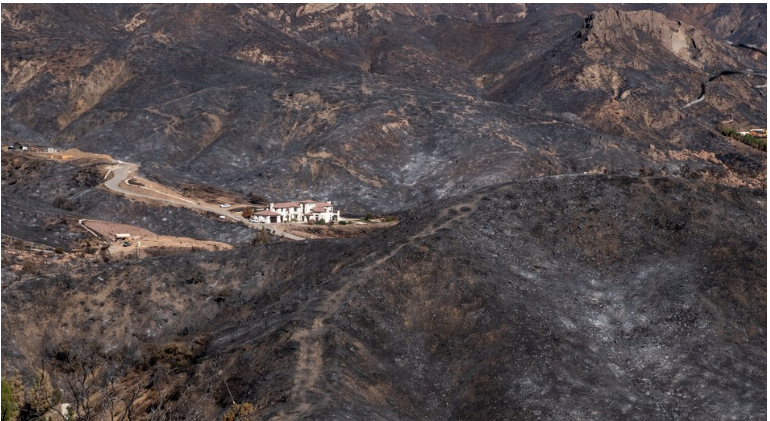CommentsDEEGAN ON LA-Malibu, already famous, captured attention a couple of weeks ago when it came perilously close to being torched and ruined by the horrific Woolsey Fire that forced a total evacuation by residents of the seaside enclave, as fire ravaged the hillsides and threatened the community.
Damage was so extensive that officials have estimated it could take ten to twenty years for hillside vegetation and habitat to recover. The size of the burn was 97,000 acres, so large that it could possibly be viewed from space.
For residents, some of whom lost their homes, recovery will be quicker than for the wildlife and vegetation but the metaphor the fire created -- “burning like Malibu” -- may last for a long time to signify any situational paradise that turns into a looming hell.
We have little else like it in Los Angeles -- the beautiful beach lapped by Pacific Ocean waves that attract surfers, the beachfront mansions just steps from the sandcastles built by kids, hillside homes basking in incredible sunsets, the gloss of wealth, privilege and beauty that reflects back on those of lesser means who also live and visit there. Three syllables evoke a coveted image and lifestyle: Mal-i-bu. Even going to school there is dreamy: “I go to Malibu High.”
All of that was almost lost, highlighting how fragile it is to live in the hills, whether it be on the coastline or on the City or Valley side of the Santa Monica Mountains. The fire threatens not only people. The Woolsey Fire destroyed chamise chaparral, coastal sage scrub, live oak woodland, cypresses, pines and eucalyptuses that will all need time to propagate and grow back. One of the thirteen GPS-tagged mountain lions was found dead. The other twelve moved westward away from the burning hills. Countless mule deer, coyotes, bobcats, gray foxes, squirrels, gophers, mice, rats, rabbits, reptiles, and raptors perished or were forced to find new habitats. Homecoming will take many years for these victims of the Woolsey Fire.
According to the California Department of Forestry and Fire Protection, Cal Fire, the Woolsey Fire destroyed 1,500 structures and damaged 341. Significant damage was made to the tinder-dry hillsides that became targets of hot Santa Ana winds originating in the desert to our east. These winds built into a red-hot fever as they passed westward over the flat San Fernando Valley floor until climbing up the mountainside. Downdrafts acted as bellows, with flames starting at the top of the Santa Monica Mountains and accelerating rapidly from 3,000 feet to sea level, threatening storied Malibu canyons like Encinal, Zuma, Trancas, Tuna, Topanga, Las Virgenes, Decker, Carbon, and Latigo.
The City of Malibu has a population of 12,877 people compared to over four million in the whole City of Los Angeles. So, why should we worry about fires there? Because, they are a metaphor in that we are also blessed with advantages but exposed to the dangers of “burning like Malibu” when expectations are not met.
Of course, a metaphor is not literal, but a symbol represented in an abstract way. Los Angeles won’t be literally “burning like Malibu,” nor will our issues burn us down, even though the 1992 “Rodney King” riots came very close. But Los Angeles does burn with issues that, like Malibu burning, disrupt our civic and social life, bringing tension and distress as serious as the possibility of losing a home or hillside to an inferno as was experienced by Malibu residents.
Living in Los Angeles is tantalizing, as seductive as living in one of the many coastal communities that dot our Pacific Ocean shoreline. We have beautiful buildings, but it costs a lot to live in them, making affordability a burning issue. Well-designed freeways and arterial roadways are too clogged with gridlocked traffic -- an issue that makes drivers (and residents of cut-through streets) burning mad. Homeless people with ample resources available are often slow to take action, even if a fire is lit beneath them. Politicos make promises to get our votes but then turn around and scorch us with their votes. Our problems involve structure and infrastructure while Malibu’s problems center around living with nature.
When we are “burning like Malibu” in Los Angeles, our heat can be resolved politically in the civic arena. While “burning” immediately suggests destruction, there is also an element of purification. Malibu will recover, as it has from previous fires. Los Angeles will also survive as its “burning like Malibu” activist communities strive to get ahead of the issues that threaten us.
(Tim Deegan is a civic activist whose DEEGAN ON LA weekly column about city planning, new urbanism, the environment, and the homeless appear in CityWatch. Tim can be reached at [email protected].) Edited for CityWatch by Linda Abrams.
